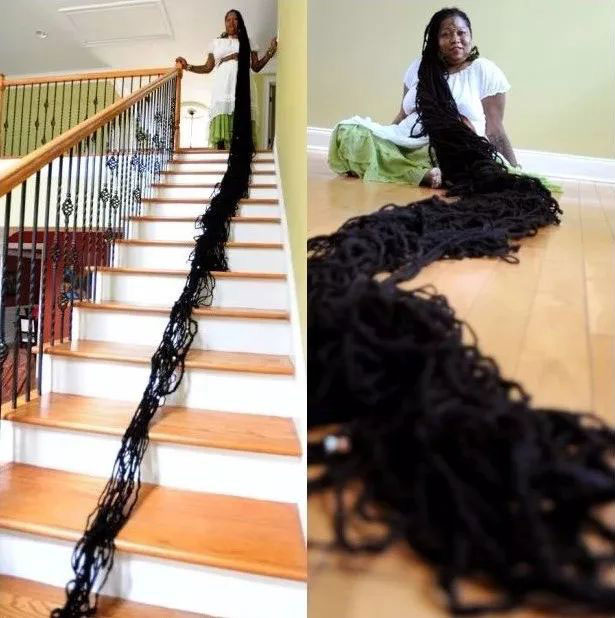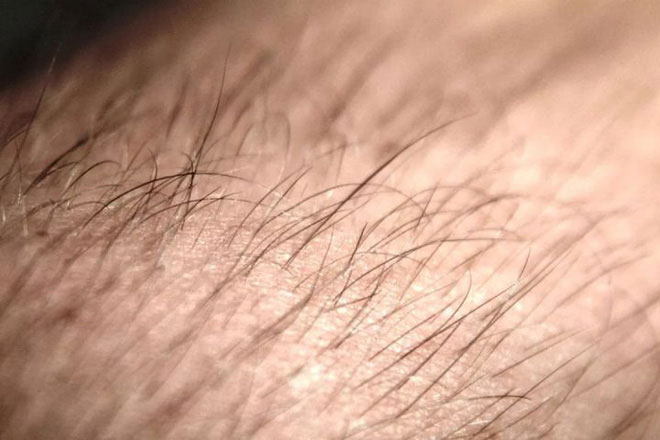Why do people have to cut their hair and not other animals?
Hair and hair are a feature of mammals, even those that look smooth like hippos, elephants, rhinos, naked mole mice and even whales or whales are no exception.
Although they have removed most of their body hair to adapt to the environment, they still retain their fur to a certain extent.

Hair, hair is a characteristic of mammals.
But among mammals, humans are completely separate and have a fur, especially hair that is different when compared to other species because without cutting your hair can grow very long, while in other species when reaching a certain length, it will stop.
So how long can human hair be without cutting? Perhaps people have thought about this, but it has never been verified by actual action.
But never mind, people always like to challenge their limits, although they can not leave their hair for life, but in America there is a 50-year-old woman who has not had a haircut in 40 years. In March 2016, her hair was recognized by the Guinness Book of World Records with a length of 16.8 m.

Woman with long hair is recorded in Guiness record.
The growth rate of normal human hair is about 1 cm per month. Therefore, if calculated at this average speed, within 40 years, the average person's hair is only about 5 m long, so the growth rate of this woman is still a quite strange thing. .

The growth rate of normal human hair is about 1cm per month.
Hair follicles are the basic unit for hair production, and hair is derived from the growth and differentiation of cells in the hair follicles.
There are about 5 million hair follicles in the human body, of which 1 million are on the head and 100,000 to 150,000 are on the scalp. Hair follicles are located in the skin and are regulated by various hormones and growth factors. And each hair follicle also contains a group of hair follicle stem cells , a fairly complex "small tissue".
These hair follicle stem cells, like the mother of the cells surrounding the hair follicle, can continually divide to provide a continuous source of cells for growing hair follicles. These new cells can differentiate into hair, sebaceous glands, melanocytes, smooth muscle cells, etc.

About 90% -95% of hair follicles of a healthy adult scalp is normal during growth.
All life cycle of hair follicles can be divided into growth stage (Anagen), degradation (Catagen) and rest period (Telogen). About 90% -95% of hair follicles of a healthy adult scalp are normal during growth, 1% enters a recession and 5% -10% is a break.
As the name suggests, hair follicles are most active during the anagen process , and this period lasts 2-8 years. During this stage, hair follicle stem cells divide and differentiate in large numbers, and hair grows rapidly and has a strong vitality.
After the growth period, the hair follicles will stay in the catagen phase for 2-3 weeks. During this period, the cells in the hair follicles also stop growing and hair will no longer grow longer. In addition, the root of the hair will be pushed from the subcutaneous tissue to the vicinity of the hair follicle stem cell.

Hair follicles are most active in the anagen process.
After that process, the hair follicles enter a rest period of up to 2-3 months. At this point, the connection between hair and hair follicles will not be close, it can be said that the hair is "dead" and in danger of falling out at any time. Moreover, because melanin production is reduced, we can also see that the hairline is white.
But for periodic tissues such as hair follicles, death also means regeneration. In mature mammals, hair follicles are the only structure with a self-replicating structure.
After a hair follicle completes a growth cycle, it will enter the next growth phase under the stimulation of the appropriate signals. After a while, a second hair will grow out. The old hair may be intact or may be shed and replaced with a new one.
Therefore, hair is most prone to hair loss when hair follicles from the resting period enter the next growth phase . In fact, as a human, we can shed up to 100 hairs a day. But at the same time, 100 hairs respectively began to enter a new growth cycle.
In an ideal state, the amount of hair a person will maintain is stable at about 100,000 to 50,000 strands.
In fact, from the hair follicle cycle introduced above, it can be seen that hair length has periods of recession and rest, so hair will basically have a certain length, not forever.
In other words, the duration of the hair follicle growth stage determines the length of the hair. The longer the growth period, the more likely our hair is to grow.
In general, the hair follicles of the human scalp grow only 2-8 years. Therefore, the length that the hair can achieve is actually limited to a few meters.
Because of the long growth period, our hair is constantly growing and needs to be cut, while your arms, legs, eyelashes and eyebrows only have a positive growth time of about 30. up to 45 days.
So these hairs will have a shorter period of hair loss and growth, so their length is very limited and that's why long hairs in these areas will not continue to grow excessively. if not pruned.
Similarly, the hair of other mammals has the same growth cycle, the cycles of the animals' hairs are shorter than human hair so they will fall out before they can grow like human hair.
- 50 The incredible truth about hair
- Why silver hair back?
- Give back 'blue' for hair
- Why do so many young people have white hair?
- Why are eyelashes, eyebrows not growing as long as hair?
- The cure for silver hair does not require dyeing
- Prevent early causes of hair loss
- Why do dirty hair get better?
- The concept of women possessing naturally curly hair is very difficult, is this true?
- It turns out that hair dryer also has dozens of unexpected uses that few people know
- Materials simulating cilia
- 47-year-old teacher died after 10 days of dyeing her hair
 'Fine laughs' - Scary and painful torture in ancient times
'Fine laughs' - Scary and painful torture in ancient times The sequence of numbers 142857 of the Egyptian pyramids is known as the strangest number in the world - Why?
The sequence of numbers 142857 of the Egyptian pyramids is known as the strangest number in the world - Why? History of the iron
History of the iron What is alum?
What is alum? Why does gray hair never turn black again?
Why does gray hair never turn black again?  What would classic comic book characters look like if recreated with AI technology?
What would classic comic book characters look like if recreated with AI technology?  Unexpected relationship between gray hair and cancer: Harvard research clarifies the truth
Unexpected relationship between gray hair and cancer: Harvard research clarifies the truth  Solution to prevent oil pollution with human hair
Solution to prevent oil pollution with human hair  Unpredictable effects of plucking gray hair
Unpredictable effects of plucking gray hair  Strange hair syndrome that can't be combined, disappears on its own as an adult
Strange hair syndrome that can't be combined, disappears on its own as an adult 